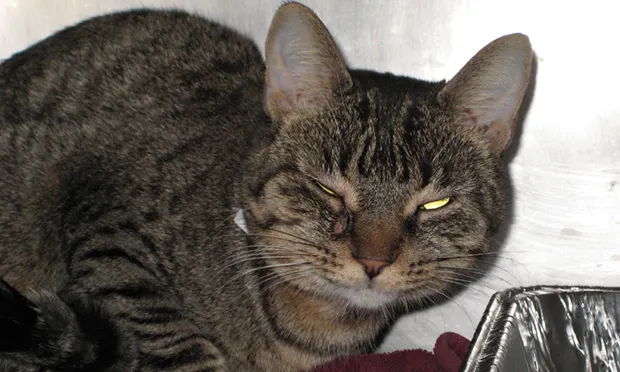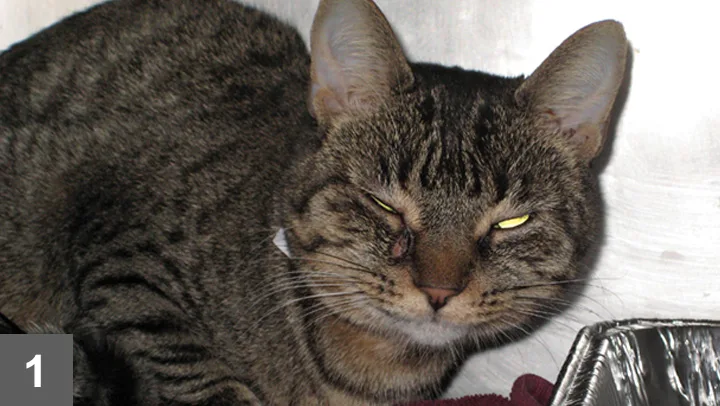Feline Calicivirus
Annette Litster, BVSc, PhD, FANZCVSc (Feline Med), MMedSci (Clin Epi), Chicago, Illinois

Feline calicivirus is a single-stranded nonenveloped RNA virus of the genus Vesivirus in the family Caliciviridae, and it can result in a wide range of clinical outcomes.
PROFILE
Definition
The feline calicivirus (FCV) genome can mutate rapidly, and repair rates are minimal, thereby increasing biotype diversity over time.
Although antigenic variability is common, all FCV isolates are grouped into a single serotype.
Debate exists among virologists regarding whether more than 1 serotype exists.1
Antigenic differences between FCV isolates create challenges for the development of broadly protective vaccines.2
Related Article: Detection of Feline Calicivirus & Herpesvirus
Systems
FCV infection is often subclinical but can be responsible for a wide variety of clinical presentations.
Clinical outcome depends on factors (eg, viral biotype, route of exposure, host age, immune/vaccination status, concurrent disease).
Clinical outcomes include:
Upper respiratory signs such as conjunctivitis and/or rhinitis, often as a coinfection with other feline upper respiratory pathogens; less commonly, bronchointerstitial pneumonia3
Oral and/or lingual ulcerations; vesicular lesions on the nasal philtrum or footpads1
Chronic gingivitis/stomatitis; faucitis4 (based on studies that have correlated clinical signs with the isolation of FCV, although attempts to reproduce disease to fulfill Koch’s postulates have not been successful, which suggests that cofactors are involved1)
Febrile limping syndrome5 (self-limiting)
Outbreaks of a highly contagious, virulent systemic disease with high mortality rates, characterized by fever, subcutaneous edema of the head and paws, severe oral ulceration, epithelial necrosis, and multi-organ failure (virulent systemic feline calicivirus, VSFCV).6,7
Managing a Virulent Calicivirus Outbreak
Incidence & Prevalence
Prevalence varies primarily according to the number of cohabiting cats, with estimates ranging from approximately 10% in pet cats housed singly or in small groups to 25% to 40% in shelter-housed cats and up to 90% in some colonies.3
Viral shedding from acutely infected and subclinical carrier cats is the most common source of infection for susceptible cats.3,8
Carriers can shed varying amounts of virus consistently or intermittently for months to years and can be responsible for maintaining high infection prevalence in group-housed cats.9
A separate group of cats appears to be resistant to infection despite constant exposure; this could be a result of a robust immune response or perhaps specific characteristics of the host viral receptors.9
Geographic Distribution
FCV has a ubiquitous worldwide distribution.1
A separate group of cats appears to be resistant to infection despite constant exposure; this could be a result of a robust immune response or perhaps specific characteristics of the host viral receptors.9
Signalment
No breed or sex predilection has been reported, although cats from breeding catteries are frequently infected, probably because of facilitated transmission in a multicat environment.9
Age & Range
Acute oral and/or respiratory signs and febrile limping syndrome are more likely to occur in kittens and young cats.3
Causes
Transmission occurs mainly by direct contact or via fomites.
Aerosol transmission plays a minor role in spreading virus over distances of more than 1.3 m, probably because of the lack of viral aerosol production and the relatively small feline tidal volume.10
As a nonenveloped virus, FCV is highly tolerant to environmental stressors, as opposed to other respiratory pathogens (eg, FHV-1), and persists for at least 1 month in a dry environment at room temperature and perhaps longer at cooler temperatures.
FCV is also more difficult to deactivate with disinfectants compared with most bacteria and enveloped viruses.
Related Article: Feline Oropharyngeal Inflammation
Risk Factors
Immunosuppressed cats and those living under environmental stress (eg, overcrowding, poor sanitation) are most at risk for infection.
Young cats and kittens are most likely to show clinical signs of disease.3
Pathogenesis
The main routes of infection are ocular, nasal, and oral.
The incubation period is 2 to 10 days.3
Viral replication occurs mainly in the oropharynx8 but can occur at other locations depending on biotype.
This causes a variety of clinical presentations.3
A viremic phase is thought to occur a few days after the initial infection and before tissue infection causes epithelial necrosis and vesicle formation.1
The pathogenesis of VSFCV could be enhanced by facilitated entrance into the circulation as either free or cell-associated virus.
VSFCV appears to have a broader tissue tropism than non-VSFCV.1

Photophobia and unilateral mucopurulent ocular discharge in a cat associated with feline calicivirus and secondary bacterial infection.
Clinical Signs
Clinical signs vary widely depending on viral biotype and host factors, but the most common clinical syndrome recognized in practice is characterized by acute upper respiratory and ocular signs in kittens or young cats (Figure 1).3
Self-limiting lameness with pyrexia may be seen, often in young cats.5
FCV infection has been associated with chronic gingivitis/stomatitis, faucitis, and/or orolingual ulcerations.1
The virulent systemic form of infection can cause pyrexia, edema of the head and paws, epithelial necrosis, severe oral ulceration and, terminally, disseminated intravascular coagulation caused by widespread vasculitis.6
Infection in chronic carrier cats is often subclinical.
Diagnosis
Definitive Diagnosis
Commercially available polymerase chain reaction (PCR) panels may assist in the identification of viral antigen in ocular, nasal, and/or oropharyngeal swab samples.
A recent study11 demonstrated that oropharyngeal or lingual specimens were more likely than conjunctival specimens to yield PCR-positive results for FCV.
Because infection can be subclinical, a PCR-positive result does not necessarily mean that FCV is the cause of the clinical signs observed.
Virus isolation can also confirm the presence of virus, but this method is used primarily in research.
The FCV genome can mutate rapidly and repair rates are minimal, thereby increasing biotype diversity over time.
Differential Diagnosis
The major diagnostic differentials for acute upper respiratory infection in cats are infections by FHV-1, Mycoplasma felis, Chlamydophila felis, and Bordetella bronchiseptica.12
Laboratory Findings
In acute upper respiratory infection, CBC and serum chemistry findings are usually within the reference range.
In more severe clinical disease, with fever, anorexia, dehydration, and/or lower respiratory tract signs, an inflammatory leukogram and electrolyte abnormalities might be observed.
Other organ-specific laboratory abnormalities depend on FCV biotype and body system affected.
Imaging
Radiographic signs of bronchointerstitial pneumonia can be present in severe disease caused by some FCV biotypes.3,6
Postmortem Findings
In virulent systemic FCV infection, postmortem findings include subcutaneous edema of the face and limbs, skin and mucosal ulceration and necrosis, bronchopneumonia, pancreatitis, hepatitis, and steatitis.6,7
Treatment
Inpatient or Outpatient
FCV should be treated on an outpatient basis, if possible, as it is highly contagious, long-lived in the environment, and commonly transmitted by fomites.
Infection Control Measures for Calicivirus
Medical
There have been sparse but promising reports of specific anti-FCV therapeutic agents,13-15 but none are currently available for clinical use.
However, supportive therapy to correct dehydration, ensure nutrition, provide analgesia, and treat biotype-specific clinical signs should be provided.
In 1 study,16 FCV-positive cats with refractory caudal stomatitis were randomly allocated to either a 3-week course of oral prednisolone or a 90-day course of topical oromucosal recombinant feline interferon omega.
Although only cats in the interferon group demonstrated a significant improvement in caudal stomatitis, alveolar/buccal mucositis, activity level, and pain scores, no significant differences were noted between treatment groups for most of the parameters studied.16
Client Education
Clients should be advised that many infected cats become subclinical carriers of the virus and that carrier cats pose a risk for infection to susceptible cats.9
In addition, the risk for chronic oral disease is increased with FCV infection.4
Relative Cost
PCR panel for feline upper respiratory tract pathogen identification (commercial laboratory): $
Supportive therapy for acute upper respiratory tract disease: $$
Prolonged supportive therapy for VSFCV until clinical resolution: $$$$
Prognosis
In most cases of acute upper respiratory tract disease, clinical signs resolve in days to weeks.
Chronic oral and gingival disease has been associated with FCV, however, and the development of a chronic viral carrier state with viral shedding is relatively common.3
Mortality rates in the virulent systemic form of the disease are high (33%–50%), and prognosis is guarded.6,7
Prevention
Vaccination against FCV is recommended as core for all cats.17
Administration should commence in pet kittens as young as 6 weeks of age and be repeated every 3 to 4 weeks until 16 to 20 weeks of age in order to overcome interference by maternally derived antibodies.
Cats starting their vaccination series at older than 16 weeks of age should receive 2 doses 3 to 4 weeks apart.
In shelters, kittens are vaccinated every 2 to 3 weeks from 4 to 6 weeks of age, and adults are vaccinated at or before shelter entry, preferably using a modified-live vaccine.
Cats should be revaccinated 1 year after the primary series, then every 3 years for life.17
FCV = feline calicivirus, PCR = polymerase chain reaction, VSFCV = virulent systemic feline calicivirus